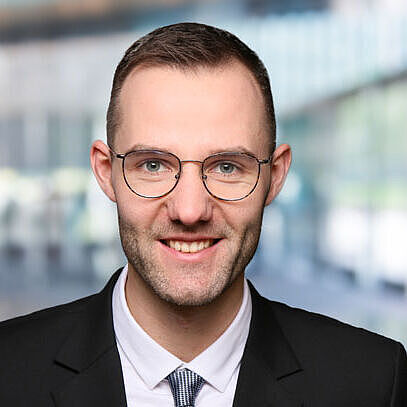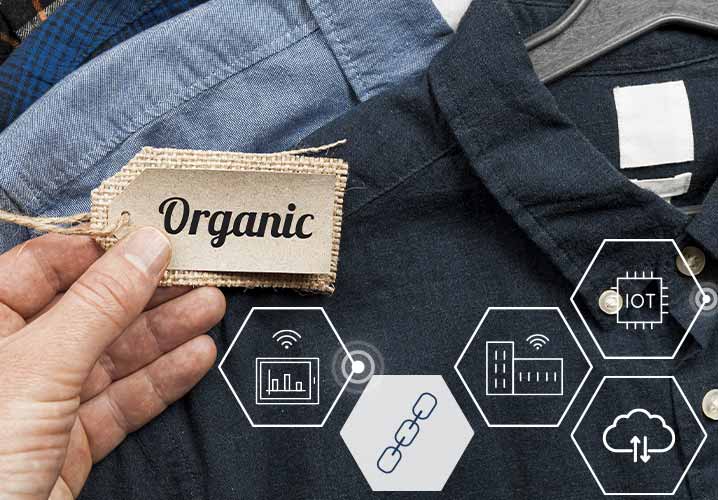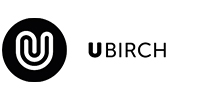
Blockchain technology ensures trust in sustainable textiles
In a production facility for sustainable textiles, compliance with specific emission thresholds must be recorded in such a way that results cannot be falsified. Blockchain and a cloud connection ensure that the measurement data on a sensor is digitally sealed and that the data cannot be changed after the fact. This way a company can be certain that its suppliers are meeting all guidelines – and therefore so is the company itself.
Challenge: reliably verifying emissions handling
In production facilities for suppliers of sustainable textiles, compliance with specific emission thresholds must be recorded and verified. The emissions in question here are volatile organic compounds (VOC), which are by-products in a number of standard processes in textile production, such as in screen printing or glueing processes. VOC emissions can be harmful to the environment and to health. For this reason, special guidelines are in place in many countries, and compliance with these guidelines is regularly audited in production halls. Conventional test processes do not involve taking constant measurements, however, and are therefore often not sufficiently reliable.
Add to this the fact that fashion trends and other developments on the market regularly create ad-hoc needs for textiles with specific properties in terms of their colour, material or printing. As a result it is often necessary to switch suppliers on short notice in order to meet demand. If the last-minute textile is now being purchased from a new supplier, verification of sustainable production conditions in the form of an audit or certification is usually not possible within the given amount of time. This is especially true for certified measurements of VOC emissions. Companies at the end of the supply chain are therefore exposed to more risks of product recalls. There may also be conflicts where corporate social responsibility and brand reputation are concerned: the textiles are declared to be sustainable, but it cannot be reliably verified that VOC guidelines were complied with during production. In this case, companies need suppliers to deliver reliable readings that cannot be falsified.
‘Using this technology, data packets are digitally sealed and linked. The level of reliability and trustworthiness is therefore extremely high.’
Solution: measurement data is digitally sealed
Blockchain technology can be used to protect data from industrial sensors. Funk and its partner UBIRCH have used this process, in which an extremely lightweight software client is installed directly on the sensor. This way the client is able to digitally seal and link the outgoing data packets. In this client case, a VOC sensor in the exhaust systems of the suppliers’ production halls delivers constant measured values on emissions for the ongoing production process.
Blockchain
A blockchain is a list of datasets, known as ‘blocks’, that are cryptographically linked, or ‘chained’. Each blockchain is stored decentralised on a number of computers in a peer-to-peer network, where data is continuously being synchronised. The result is a transparent database that is always up to date and can be accessed by all involved parties but cannot be manipulated. The technology can be used to share a wide range of data confidentially.
Using the client, digital seals are generated directly on site for measured data, linked and transferred to a cloud backend and then anchored aggregated in the blockchain from there. This solution ensures that data cannot be changed or manipulated after the fact without being noticed. Funk clients can check the integrity of the measured data of their suppliers at any time via a direct cloud connection.
Cloud computing
Cloud computing describes the approach of providing IT infrastructure (e.g. servers, databases, network components or software) via the internet so that these do not use up resources such as memory space and processing power on the user’s local computer. Such services can usually be accessed dynamically ‘on the cloud’ as needed and be charged for on a per-use basis. Falling back to cloud computing therefore corresponds to classic outsourcing in terms of providing, installing and supporting a company’s own IT infrastructures.
Benefit: more transparency, and protection of health and the environment
In this case, the innovative system allows for permanent auditing of suppliers within the supply chain for sustainable textiles. The possibility of being able to verify all measurement data against the blockchain at any time gives every partner along the supply chain – and third parties, if necessary – a reliable transparency in terms of compliance with guidelines. This reduces the risk of product recalls, damage to reputation and negative media coverage.
Accordingly, the solution also has the potential of being used with insurance against damage to reputation. With reputation cover, companies can insure themselves against lost profits or earnings as a result of negative reporting in the media and cover the costs of restoring their reputation. Such an event may occur, for example, if it becomes public that VOC thresholds were exceeded in the production of textiles sold as ‘sustainable’. The likelihood of such an event occurring can be reduced in the application case described here. Similarly positive dependencies exist with policies for covering recall costs or the even more comprehensive product protection insurance policies. Furthermore, the solution described here is also suitable as a technical starting point for parametric models in the area of non-damage business interruption insurance. Exceeding a VOC sensor reading acts here as a reliable trigger as it is protected by the blockchain technology.
The system can in principle be installed more quickly and flexibly than an on-site audit. Moreover, the simplified verifiability encourages compliance with emission guidelines and directives. Not least, the UBIRCH technology makes a valuable contribution to health and environmental protection.
Parametric insurance
In the case of parametric insurance, the insurer adjusts claims based on predefined parameters rather than later damage amounts. If a contractually agreed value range is breached as a result of an event, this ‘trigger’ automatically results in an assigned claims payment in response. Any potential deviation of the claims payment from the actual amount of damage incurred remains as the ‘basic risk’. The increasing use of modern sensors and highly developed analysis software has facilitated the constantly improved recording of damage-relevant data flows on the one hand and the development of more reliable models for correlating trigger events and damage amounts on the other.
Project progress: connecting client and sensor
Once the problem and objective are defined, the necessary scope for the sensor hardware and software infrastructure are determined. The client can be attached to existing sensors in theory, but usually a package with new sensors is used. It is similar for the software components, which can be integrated in the client’s system landscape – such as in an internet of things platform already being used – or externally provided via a web application. The cloud setup involves a trust service and connection to a public blockchain as chosen by the client. Optional items include components for storage, visualisation and verification of measurement data.
Suitable for: companies recording critical data with sensors
‘Using this technology, data packets are digitally sealed and linked,’ says Manuel Zimmermann, Beyond Insurance Manager at Funk. ‘This lends an extremely high level of trustworthiness, as each incoming data packet can be checked for authenticity and integrity before it is processed or an action is triggered.’ The sealed data packets are also anchored in multiple public blockchains. The result is a log file for one sensor or even for an entire system, which cannot be falsified and can be verified beyond system limits. As Zimmermann says, ‘The solution can be used anywhere where critical data is already being recorded or can be recorded.’
Your point of contact


Technical aspects
Harmful emission
Sensors
Blockchain
Cloud
Benefits/objectives
Risk reduction
Reputation and compliance
Environmental protection

